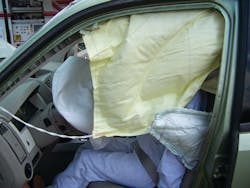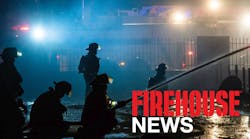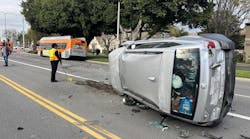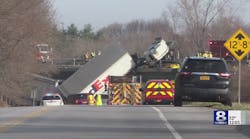SUBJECT: FMVSS 226 “Ejection Mitigation” Standard
TOPIC: FMVSS 226 Modifications to Side Window Glass and Side-Impact Airbags
OBJECTIVE: Understand how changes in side window glass and side airbags, to meet the new ejection mitigation standard, may affect medical and rescue procedures at crash scenes
TASK: The rescue team shall review department procedures for jammed door opening and dealing with deployed side airbags and consider revising them as necessary for vehicles conforming to the new FMVSS 226 Standard.
Responders to vehicles crashes involving 2013 and newer model-year vehicles are likely to begin encountering changes in door window glass as well as side-impact airbags in these newer model vehicles. This is due to a new Federal Motor Vehicle Safety Standard (FMVSS) now being phased in, which goes into full effect on September 1, 2017. The new standard, FMVSS 226, addresses “Ejection Mitigation” and is an effort to reduce ejection of belted or unbelted occupants during rollover collisions, particularly through side windows. To comply with this standard, automakers will be modifying their side window glass as well as changing side-impact airbags to keep occupants inside the vehicle during a rollover.
What changes can we expect?
The National Highway Traffic Safety Administration (NHTSA) reports that rollover crashes remain second only to frontal crashes as a source of passenger vehicle fatalities. In 2009 for example, 35 percent of all crash fatalities were from rollovers. What really caught NHTSA’s attention is data showing that almost one of every two rollover fatalities were occupants completely ejected from their vehicle.
Responders should anticipate that one of the ways manufacturers will meet the ejection standard requirements will be by modifying existing side-impact airbags. EMS and rescue personnel should expect to see larger side-impact airbags, especially the roof-mounted ones. Larger side airbags will not only cover more of the window openings to keep occupants inside but, for EMS personnel, they will also increase the obstruction they present when we make patient contact.
In addition, it will become common that roof airbags deploy in rollover crashes. Many vehicles currently have roof airbags that not only deploy for side impacts but also deploy when they sense a rollover event as well. This will become the norm.
FMVSS 226-compliant roof airbags will most likely also be designed to remain inflated longer to outlast the five or six seconds of a multiple rollover collision. We may see tether straps introduced to secure the larger airbags near the base of the vehicle’s pillars.
Along with changes to side airbags, responders will more frequently encounter laminated safety glass instead of tempered glass in the side windows next to the first three rows of seats. Referred to as advanced glazing, laminated safety glass is what we are used to for vehicle windshields. Laminated side window glass will be yet another ejection mitigation method. NHTSA researchers report that side window ejections account for 62 percent of all fatal occupant ejections in all crashes.
Excluded from this new FMVSS standard are convertibles; law enforcement vehicles; correctional institution vehicles; taxis and limousines with a fixed security partition separating the first and second or second and third rows; and passenger vehicles over 10,000 pounds gross weight.
TASK: The rescue team shall review department procedures for jammed door opening and dealing with deployed side airbags and consider revising them as necessary for vehicles conforming to the new FMVSS 226 Standard.






